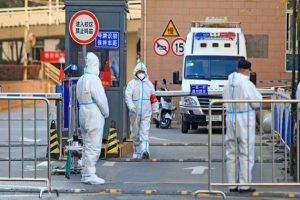China give out on Wednesday the most extensive changes to its tough anti- COVID authorities since the pandemic began three years ago, loosening rules that curbed the spread of the virus but had hobbled the world’s second largest economy and sparked protests.
COVID authorities since the pandemic began three years ago, loosening rules that curbed the spread of the virus but had hobbled the world’s second largest economy and sparked protests.
The relaxation of rules, which include allowing infected people with mild or no symptoms to quarantine at home and dropping testing for people travelling within the country, are the strongest sign yet that Beijing is preparing its 1.4 billion people to live with the disease.
The announcement quickly soared to the top most viewed topic on China’s Weibo platform, with many people cheering the prospect of travelling, though some expressed worries about the greater potential for infections.
“It’s time for our lives to return to normal, and for China to return to the world,” wrote one Weibo user.
Analysts too, welcomed the shift that could reinvigorate China’s sagging economy and currency and bolster global growth.
“This change of policy is a big step forward,” said Zhiwei Zhang, chief economist at Pinpoint Asset Management. “I expect China will fully reopen its border no later than mid 2023.”
Under the new guidelines announced by the National Health Commission, the frequency and scope of PCR testing – long a tedious mainstay of life in zero-COVID China – will be reduced.
Lockdowns – a major source of public anger – will also be limited to as small a scope as is feasible, and authorities are required to free areas that show no positive cases after five days.
People with non-severe COVID-19 infections can isolate at home instead of centralised government facilities.
The announcement came after President Xi Jinping, who regards China’s relentless fight against COVID as one of his main achievements, chaired a meeting of the Communist Party’s Politburo on Tuesday.
Cities across China were gripped by protests over tough COVID policies late last month, in what was the biggest show of public discontent since Xi came to power in 2012.
While those protests petered out in days amid a heavy police presence, cities and regions around the country started announcing a mish-mash of easing measures that fed expectations for Wednesday’s announcement.
Many of the steps taken by individual cities or regions were reflected in the list of policy changes issued by the National Health Authority on Wednesday.
Officials have also been softening their tone on the health risks of the virus – bringing China closer to what other countries have been saying for more than a year as they dropped restrictions, and shifted towards living with the virus.
Gu Xiaohong, a top traditional Chinese medicine official, was quoted in the state-run Beijing Daily on Wednesday as saying China should change its official name for COVID-19 to reflect the virus’ mutation and that patients with light symptoms could recuperate at home.
China’s yuan CNY=CFXS has seen a recent resurgence against the dollar, buoyed by the prospects that government would relax its “zero-COVID” policy.
But the currency remains set for its worst year since China unified official and market exchange rates in 1994, as its economy has been battered by COVID curbs.
In further evidence of that, China’s exports and imports shrank at a much steeper-than-expected pace in November, data on Wednesday showed.


